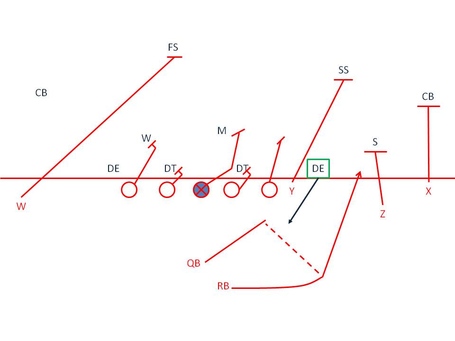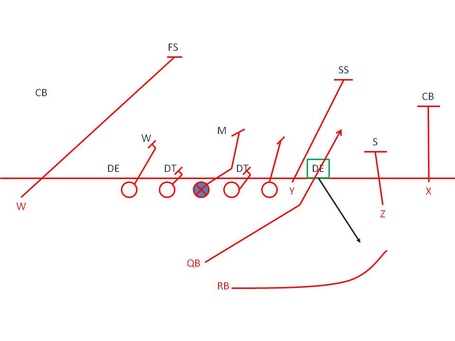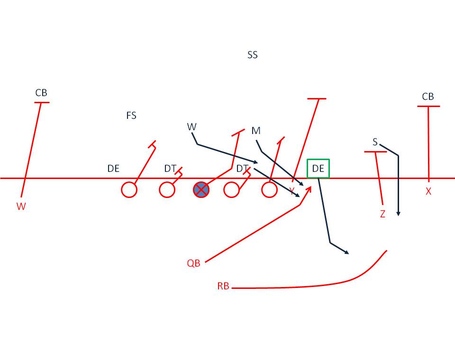Inside the Playbook: Defending the Speed Option in Cover 1 (Preview)
Leaving the offense for a minute, perhaps the most aggravating thing from the Nebraska game was Michigan's inability to defend the speed option. Unfortunately, this has seemed to be a common trend for the Mattison defenses since his arrival back in Ann Arbor. But why? Is Michigan doing something inherently too difficult to accomplish? What are they really asking their defense to do? In this post, we will look at how Michigan has tried to defend the speed option in the past, what went wrong against Nebraska, and how Michigan will look to fix this issue this year.
How the Speed Option is Run
Be it under center or from the shotgun, the speed option is essentially the same. The offensive line, in the case of most modern day offenses, will run their standard outside zone blocking scheme. The one difference is that the offense will bypass the defense's EMOL toward the play and instead work to the 2nd level. The defender left free with be the option defender, the player that the QB will read to determine if he will keep the ball and run it himself or pitch the ball to his RB.
Here is how it looks:
Who Is the Danger?
How the defense plays the speed option will depend on who they believe is the most dangerous player with the ball in their hands. For Northwestern, Michigan thought Colter was more dangerous than their random assortment of backup QBs. Against Nebraska, the highly skilled Ameer Abdullah was the person Michigan didn't want to see the ball go to. How they scouted and prepared show in how they defended the zone against these teams.
Against the spread, there are really three primary defenses teams will play: Cover 1, Cover 3, and Cover 4. We will discuss how Michigan will use these coverages (this post will focus on Cover 1) and how they'll plan to defend the speed option from these coverages.
Defending Speed Option in Cover 1
Michigan went primarily to a cover 1 defense for several reasons against Nebraska: 1) they didn't believe the Nebraska QBs - mostly Armstrong, but also Kellogg - could throw the ball on their defensive backs playing a relatively tight man coverage; 2) this allowed them to commit all but one safety and the remaining man-to-man match ups to Nebraska's run game; 3) it allowed them to run a scheme intended to keep the ball out of Ameer Abdullah's hands on the edge.
Point 1 and 2 went a-ok. But 3, well, it went less so.
Responsibility in this case goes:
RB: DE and slot defender/box safety
QB: Inside pursuit LBs and DTs
Here's how it is intended to look:
So what's going on here?
Defensive End
The defensive end is tasked with getting up field and keeping some initial relation with the RB. Of course, he can't just mirror the playside shoulder of the RB because that would give the QB a clear and quick lane to cut up field in, before the pursuit could get to him. So the DE will tend to work upfield approximately at the same angle as the pitch relation. You'll hear a wide range of what offensive coaches believe is the proper pitch relation, but it tends to be something about 4 yards deeper than the QB and 2 yards in front of the QB (depending on scheme, formation, it could be 4x4 or 1x4, it really depends).
Once his upfield shoulder gets even with the QB's downfield shoulder, the DE can focus on collapsing down on the QB. That is because by this point, the QB has been forced off his track (he ideally wants to attack right outside the offensive EMOL, but because the DE gains depth, he must flatten out) and to flatten out. This disrupts the proper pitch relationship, and with the DE aiming at the QB's pitch shoulder, any pitch is dangerous and perhaps forced to go through the body of the DE.
This sort of technique also slows the QB down, as he's forced to attack the DE who initially is giving a little bit of space, but is still threatening to crash down. On top of that, the QB is forced to think rather than being able to make a quick, crisp read. All this should allow pursuit to get to the QB.
Slot Defender/Box Safety
The slot defender or box safety will be required to keep everything inside of them. This means that this defender, who is responsible for the alley, must keep his outside shoulder free at all times. That's not exactly extremely difficult in this case, though not exactly easy either.
For a slot defender aligned toward the hash, in Cover 1 he will maintain initial outside leverage (his help is inside, from the LBs). He cannot allow the receiver's initial release to easily cross his face, both for pass coverage reasons and for run support reasons. His off man position allows him to get a good read of the receiver's stem, and lets him judge if the receiver is going into a route or blocking him. Once he sees the QB attacking his side of the field and feels the WR preparing to block, he must shoot upfield and attempt to constrict the alley. This means he cannot gain width and cannot afford to get washed down. He must anchor and hold his position. While the DE is stretching the play horizontally, that combined with the slot defender will constrict any running lanes for the RB (any late pitch to the RB should either put him in a position where the alley defender has outside arm free and support from the sideline, if not that, then any late pitch or pitch relationship that actually allows the RB to get the football will force him to cut back to the pursuing DE along with other pursuing defenders).
As for the box safety, the theory is similar. While he isn't split out as wide (typically the box safety will come up from the boundary) he is in a position to beat blocks to the spot and maintain outside leverage. In this way, it's easier to constrict the alley.
The hard part here, obviously, is maintaining both run and pass responsibility. It is up to properly reading keys to allow this to happen.
Inside LBs
The ILBs in this case are pursuing the play from inside out. Their first responsibility is to make sure the QB can't shoot directly up field to gain yardage. To do so, they must come underneath (upfield) of their blockers. By attempting to go over the top they can easily be washed outside, you combine momentum with the addition of large bodies blocking and it's easy to see how they can easily get sealed outside and allow for a big play to arise from a QB cutting back.
So the LBs must consistently work to get upfield of their block and pursue from through the QB to the RB (after the pitch).
How the Speed Option is Run
Be it under center or from the shotgun, the speed option is essentially the same. The offensive line, in the case of most modern day offenses, will run their standard outside zone blocking scheme. The one difference is that the offense will bypass the defense's EMOL toward the play and instead work to the 2nd level. The defender left free with be the option defender, the player that the QB will read to determine if he will keep the ball and run it himself or pitch the ball to his RB.
Here is how it looks:
Who Is the Danger?
How the defense plays the speed option will depend on who they believe is the most dangerous player with the ball in their hands. For Northwestern, Michigan thought Colter was more dangerous than their random assortment of backup QBs. Against Nebraska, the highly skilled Ameer Abdullah was the person Michigan didn't want to see the ball go to. How they scouted and prepared show in how they defended the zone against these teams.
Against the spread, there are really three primary defenses teams will play: Cover 1, Cover 3, and Cover 4. We will discuss how Michigan will use these coverages (this post will focus on Cover 1) and how they'll plan to defend the speed option from these coverages.
Defending Speed Option in Cover 1
Michigan went primarily to a cover 1 defense for several reasons against Nebraska: 1) they didn't believe the Nebraska QBs - mostly Armstrong, but also Kellogg - could throw the ball on their defensive backs playing a relatively tight man coverage; 2) this allowed them to commit all but one safety and the remaining man-to-man match ups to Nebraska's run game; 3) it allowed them to run a scheme intended to keep the ball out of Ameer Abdullah's hands on the edge.
Point 1 and 2 went a-ok. But 3, well, it went less so.
Responsibility in this case goes:
RB: DE and slot defender/box safety
QB: Inside pursuit LBs and DTs
Here's how it is intended to look:
So what's going on here?
Defensive End
The defensive end is tasked with getting up field and keeping some initial relation with the RB. Of course, he can't just mirror the playside shoulder of the RB because that would give the QB a clear and quick lane to cut up field in, before the pursuit could get to him. So the DE will tend to work upfield approximately at the same angle as the pitch relation. You'll hear a wide range of what offensive coaches believe is the proper pitch relation, but it tends to be something about 4 yards deeper than the QB and 2 yards in front of the QB (depending on scheme, formation, it could be 4x4 or 1x4, it really depends).
Once his upfield shoulder gets even with the QB's downfield shoulder, the DE can focus on collapsing down on the QB. That is because by this point, the QB has been forced off his track (he ideally wants to attack right outside the offensive EMOL, but because the DE gains depth, he must flatten out) and to flatten out. This disrupts the proper pitch relationship, and with the DE aiming at the QB's pitch shoulder, any pitch is dangerous and perhaps forced to go through the body of the DE.
This sort of technique also slows the QB down, as he's forced to attack the DE who initially is giving a little bit of space, but is still threatening to crash down. On top of that, the QB is forced to think rather than being able to make a quick, crisp read. All this should allow pursuit to get to the QB.
Slot Defender/Box Safety
The slot defender or box safety will be required to keep everything inside of them. This means that this defender, who is responsible for the alley, must keep his outside shoulder free at all times. That's not exactly extremely difficult in this case, though not exactly easy either.
For a slot defender aligned toward the hash, in Cover 1 he will maintain initial outside leverage (his help is inside, from the LBs). He cannot allow the receiver's initial release to easily cross his face, both for pass coverage reasons and for run support reasons. His off man position allows him to get a good read of the receiver's stem, and lets him judge if the receiver is going into a route or blocking him. Once he sees the QB attacking his side of the field and feels the WR preparing to block, he must shoot upfield and attempt to constrict the alley. This means he cannot gain width and cannot afford to get washed down. He must anchor and hold his position. While the DE is stretching the play horizontally, that combined with the slot defender will constrict any running lanes for the RB (any late pitch to the RB should either put him in a position where the alley defender has outside arm free and support from the sideline, if not that, then any late pitch or pitch relationship that actually allows the RB to get the football will force him to cut back to the pursuing DE along with other pursuing defenders).
As for the box safety, the theory is similar. While he isn't split out as wide (typically the box safety will come up from the boundary) he is in a position to beat blocks to the spot and maintain outside leverage. In this way, it's easier to constrict the alley.
The hard part here, obviously, is maintaining both run and pass responsibility. It is up to properly reading keys to allow this to happen.
Inside LBs
The ILBs in this case are pursuing the play from inside out. Their first responsibility is to make sure the QB can't shoot directly up field to gain yardage. To do so, they must come underneath (upfield) of their blockers. By attempting to go over the top they can easily be washed outside, you combine momentum with the addition of large bodies blocking and it's easy to see how they can easily get sealed outside and allow for a big play to arise from a QB cutting back.
So the LBs must consistently work to get upfield of their block and pursue from through the QB to the RB (after the pitch).
* * * * * * *
To watch examples of how Michigan struggled defending Nebraska's speed option out of their Cover 1, and how they successfully ran it as well, check out the full article at Maize n Brew






Comments
Post a Comment